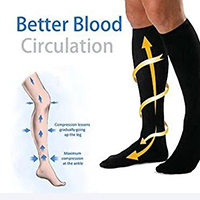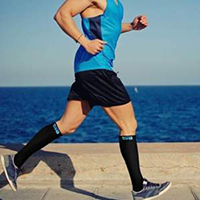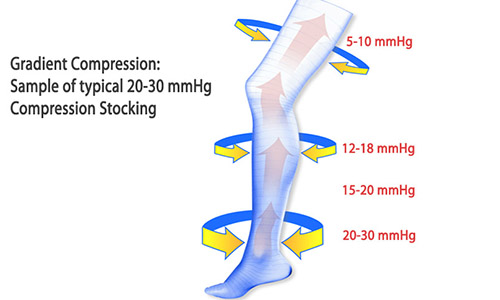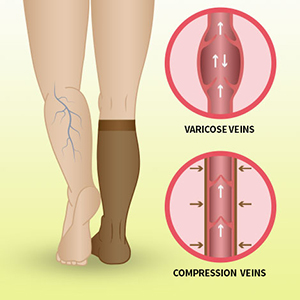When it comes to wearing compression socks, the days of your grandpa’s old white or brown compression “hose” or “stockings” have passed us by. And we should be thankful!
Today’s array of compression socks are designed to not only be therapeutically effective but also to be attractive for the modern man to want to wear. And this is great news for men who seek the health benefits of compression socks but also want to look cool and trendy doing it!
Compression socks for men come in a variety of sizes, pressure ranges and designs, so you might be confused as to which ones would be best for you. Here, we’ll take a look at how to choose the best compression socks for men so you can get the most out of your purchase.
What are Compression Socks for Men?

Whether you’ve been struggling with swelling in your ankles, varicose veins in your calves, or another issue that has caused you to seek out compression socks, you’re certainly not alone. Compression socks work well as a non-invasive therapy option for men who need just a little extra support in their daily lives.
Compression Socks for Swelling
Many doctors recommend the use of compression socks for men who struggle with extra fluid buildup around their ankles and feet. For folks who stand a lot and are unable to put their feet up, as well as for avid travelers, compression socks work against gravity by placing pressure on the legs from the outside. This pressure can keep the fluid from sinking down into the lowest areas of the ankles and feet, reducing puffiness and swelling.
Compression Socks for Circulatory Health

When the circulatory system is under strain and gravity pulls blood to the bottom of the legs, it can be difficult for that blood to return back up to the heart. This, in turn, can cause stress on the veins and result in the pooling of blood in certain areas–often in the calves. When this happens, knotty-looking and discolored veins appear often that can be painful and uncomfortable as well as unsightly.
Compression socks support the circulatory system, working against gravity to reduce the effects of varicose veins and provide relief. Not only that, but compression socks can also be worn preventatively to keep varicose veins and spider veins from forming.
In addition to varicose veins, compression socks may be used to reduce the risk of blood clots that could form in the legs, which may be hazardous to the health or even fatal.
Compression Socks for Athletes

Some men who spend a lot of time working out, running, playing basketball or participating in just about any athletic activity may find that compression socks and compression stocking are helpful for them. Football players and wrestlers who are standing on their feet a lot may find compression socks useful for varicose veins. In addition, many athletes attest to the fact that compression socks worn during sports help to promote circulation which stimulates oxygen and aids with performance.
Those recovering from sports injuries may find that using compression socks on a regular basis is able to promote a faster recovery than trying to heal without the use of compression socks. And people who wear compression socks during a rigorous workout often report that they have less soreness and cramping than when they don’t wear the compression gear because lactic acid is less likely to be able to build up within the muscles due to the pressure.
Compression Sock Pressure Ranges
Compression socks come in a multitude of ranges, tailored to the specific needs of individuals. Pressure is measured in mmHg, or millimeters of mercury, which is the same measurement used in blood pressure cuffs.

Pressure ranges for compression socks for men are typically as follows:
- 8 to 15 mmHg –this is the lowest pressure and is normally used for bedridden patients.
- 15 to 20 mmHg –this pressure is often used for those who want to fight the effects of travel.
- 20 to 30 mmHg — this is the most commonly used pressure, prescribed by doctors for those wanting to ward off varicose veins or fight against edema.
- 30 to 40 mmHg — this higher pressure sock would be prescribed by a doctor for more complicated medical conditions.
How Compression Socks Work
Most compression socks are designed with gradient pressure that allows the blood and other fluids to be pushed up from the ankle to fight against gravity. The key to this is having the highest pressure around the ankle and then the pressure lowers as it moves up the calf (and thigh if the compression socks are thigh-high).

By preventing the pooling of blood and fluid in the lower extremities and pushing blood flow back up to the heart, compression socks improve circulation. This provides more flow of nutrient-and-oxygen-rich blood to the muscles, tendons and veins to keep the active body healthy and reduce strain on the legs. For people with injuries, this can help to speed up the recovery process and people who have a propensity toward swelling in the ankles and feet may find it reduced with the use of compression stockings or socks.
What are the Benefits of Compression Socks?
Compression socks come with a whole host of healthy therapeutic benefits, including:

- Increased Blood Flow: Wear men’s 20 to 30 mmHg knee high support hose to help increase circulation and help flush metabolic waste from your muscles.
- Reduced Risk of Blood Clots: for patients who are immobile, have DVT (deep vein thrombosis) or are otherwise at risk of blood clots, doctors may prescribe the use of compression socks.
- Prevent Varicose Veins: Those at risk of varicose veins or spider veins may wear compression socks to help alleviate gravity’s strain on the circulatory system.
- Improved Lymphatic System: When your lymphatic system becomes blocked, it may be difficult to drain and circulate fluid. As a result, the fluid has nowhere to go and collects in the feet, ankles and legs, causing uncomfortable swelling. Compression socks may help with this.
- Reduced Restless Leg Syndrome: Some people use compression stockings to relieve discomfort from restless legs while sleeping. Check with your doctor before self-diagnosing.
- Improved Performance and Recovery after Running: The main basis behind wearing thigh-high and knee-high support hosiery in a run is that they help improve blood flow to the heart, which may effectively increase endurance in a run. Support compression hosiery may also help enhance muscle strength in order to eliminate muscle fatigue and reduce the feeling of cramping and soreness after a difficult workout.
- Economy Class Syndrome: This is a condition that will affect you when you sit in a confined space for a long period of time, such as on an airplane or in a car. When you are confined to a tight space, your bent legs will cause the blood circulation to be poor in your legs. Compression socks may help to alleviate this.
How to Measure for Compression Socks
Men have different legs sizes that must be considered when shopping for thigh-high or knee support compression stockings. If you’re looking for a compression range higher than 20 mmHg, your doctor will likely write you a prescription and make recommendations on which type of socks to buy. However, you’ll need to measure your legs so that you are sure to get the right size in order for them to work effectively.
When measuring for compression socks, use a fabric or paper tape measure to wrap around the largest part of your ankle and note the size. Then measure around the largest part of your calf and note that measurement. If you’re getting the thigh-high version, you’ll also need to measure around the largest part of your calf. Then, take a measurement from the floor to the back of your knee (for calf-length compression socks) or thigh (for thigh-high compression socks).
If you can’t seem to reach around or down in order to measure, it may be useful to have someone help you so that you can be sure to get an accurate measurement.
Factors in Choosing Compression Socks for Men
Fit: You’ll want compression socks that are functional and provide you with the support you need. If your compression socks are too loose, they’ll be likely to fall down and not provide you with the pressure support you need. If they’re too tight, you’re at risk of limiting circulation and having the opposite effect of what you want. Compression socks that fit should feel snug but not uncomfortably or painfully tight.
Materials: Compression socks should be made from fabrics that are stretchy and can provide durability as well. Nylon and polyester are two commonly used fabrics that are often blended with elastane (Spandex) to get the proper amount of stretch.
Pressure Level: If you are using compression socks for medical reasons, your doctor or pharmacist will recommend the right amount of pressure for your situation. Some brands only supply the most common pressure, 20-30 mmHg, others may only offer lower pressures. The brand you choose will need to fit into what your therapeutic needs are.
Sizing: While a few brands might claim that their compression socks are one-size-fits-all, this should be cause for alarm. Because of the way that the socks provide pressure is directly related to the fit, it is important to make sure you wear a size that is for you, not very everyone in the world!
Money-Back Guarantee: When you are purchasing a product, especially online when you aren’t quite sure what you are getting, it is important to be sure the company will stand behind their product. Choose a brand of compression socks that offers a customer satisfaction policy that allows for exchange or refund if the product doesn’t work for you.
Styles and Colors: Just because you need to wear compression socks doesn’t mean you don’t want to look great too! Choose a company that offers compression socks in a range of styles and colors that will fit with your wardrobe.
Popular Articles on ComproGear
Best Compression Socks for Sitting All Day Best Programing Socks
How to Put On Compression Socks
If you aren’t exactly sure how to get your compression socks on easily, you can ask your pharmacist for help. Many people find it is easiest to turn them inside out and then roll them up over the toes, around the bottom of the foot, over the ankle and up around the calf. It is important not to fold or roll the top of the compression sock down as this increases the amount of pressure and could cause discomfort or leave red marks.
Some people who struggle to get their compression socks on may choose to purchase a device (called a donner or doffer) to help get socks on and off. In general, however, once you are accustomed to them, wearing your compression socks becomes second nature and you can do it easily.
Most doctors recommend putting compression socks on first thing in the morning before the legs have a chance to swell with gravity. Wear them throughout the day and take them off at night before getting into bed, or whenever you can elevate your feet to fight against gravity.
Compression socks for men can be a great help for people who have medical issues, those who want a more comfortable way to deal with swelling, or athletes who want to add an edge to their performance. Whatever reason you decide is best for you, try out compression socks to get the most out of your legs and your life each day!
This page last updated December 15, 2022
